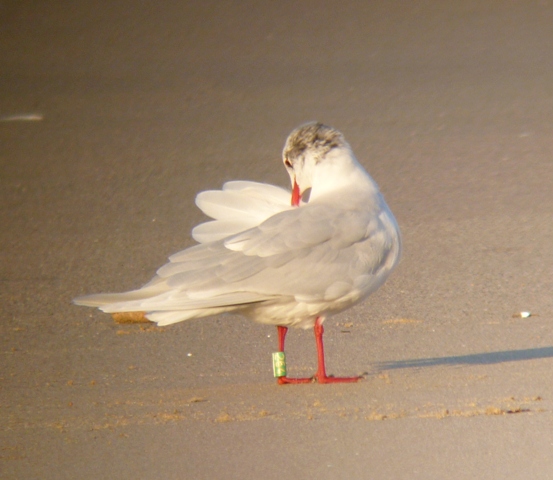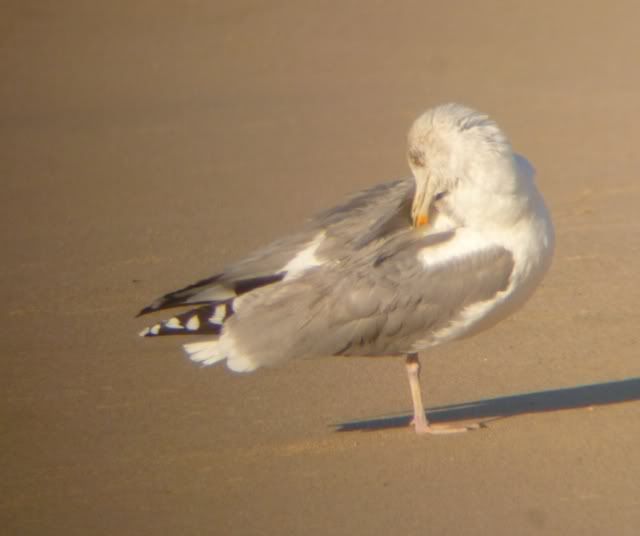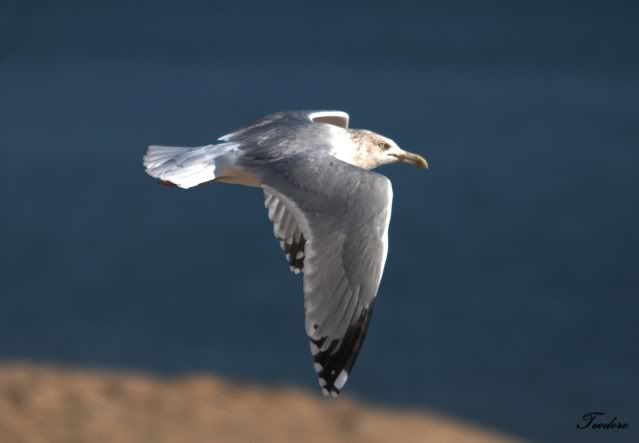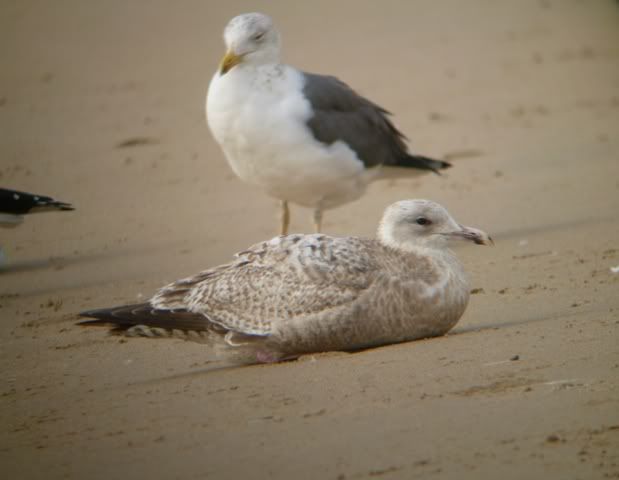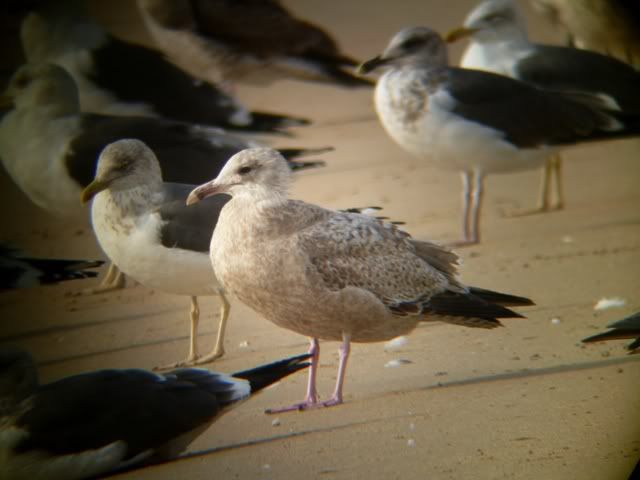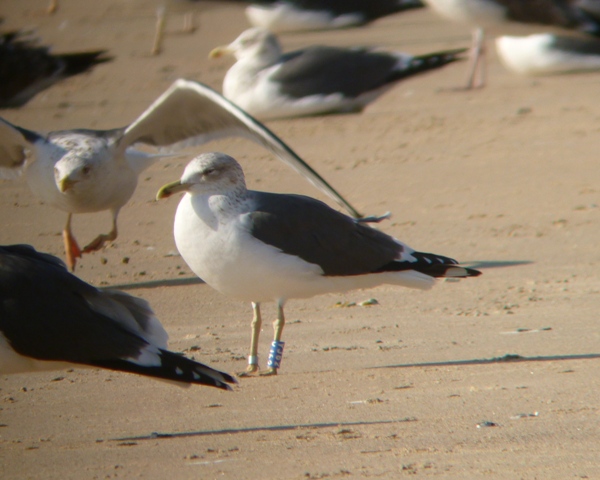Armando Caldas, as send me some nice photos, of two 1st winter Glaucous Gulls Larus hyperboreus at Viana do Castelo fishing harbour.
With his courtesy I present the big boys that came from the north...
I wonder if this Great black backed Gull Larus marinus, is having second thoughs about being the "big" bird of the block....
You can visit Armando Caldas gallery´s at Flickr click here
Sunday, 29 January 2012
Green 264, from France
Sunny wintering days with calm wind conditions, are no good for mediterranean gull ring reading at Dafundo, few of them have been seen roosting here this winter.
27.01.2012 Dafundo beach - adult Med Gull in winter plumage
Green 264 its a french ring from Camille Duponcheel
A quick run to Carcavelos parking lot today 28.01.2012, as usual a few Lbbg present at the place.
Black 3.P7 - Adult Lbbg ringed by Paul Veron
27.01.2012 Dafundo beach - adult Med Gull in winter plumage
Green 264 its a french ring from Camille Duponcheel
A quick run to Carcavelos parking lot today 28.01.2012, as usual a few Lbbg present at the place.
Black 3.P7 - Adult Lbbg ringed by Paul Veron
Thursday, 26 January 2012
Iceland Gull at Peniche
Pedro Ramalho, send me this video from Peniche. On 23.01.2012 he spotted this beautiful 3rd winter Iceland Gull at Foz da Ribª de S. Domingos, together with João Jara and Peter Alfrey.
Saturday, 21 January 2012
Fonte da Telha 21.01.2012
Today at Fonte da Telha, mainly Lesser black backed gulls present, but only 3 were ringed. Various flocks roosting along the beach, sometimes gathering 150 individuals or more, but continuosly moving, disturbed by the presence of morning walkers.
One adult Great black backed Gull, in the center.
Black 1.S8, Lesser black backed gull, ringed by Paul Veron, its a regular visitor also at Dafundo beach.
White 3.V3 Lesser black backed gull ringed by Paul Veron. Wich age??
White 7.T2 Lesser black backed gull ringed By Paul Veron
One adult Great black backed Gull, in the center.
Black 1.S8, Lesser black backed gull, ringed by Paul Veron, its a regular visitor also at Dafundo beach.
White 3.V3 Lesser black backed gull ringed by Paul Veron. Wich age??
White 7.T2 Lesser black backed gull ringed By Paul Veron
Thursday, 19 January 2012
Another Herring in Lisbon area..
Another Herring from the last days. Several have been reported this month in Portugal, in Lisbon area at least 4 to 5 diferent gulls, 3 adults, 1 st winter, and a 3rd winter in the south side of the estuary mouth.
Dafundo beach 06.01.2012 - Adult Herring Larus argentatus argentatus.
Darker mantle, very much like our Yellow legged gulls, combined with primary pattern, and still growing P10, make it a good candidate for the northern subspecies.
Dafundo beach 06.01.2012 - Adult Herring Larus argentatus argentatus.
Darker mantle, very much like our Yellow legged gulls, combined with primary pattern, and still growing P10, make it a good candidate for the northern subspecies.
With the courtesy of Isidoro Soares Teodoro,
Adult Herring 28.12.2012 at Santo Amaro de Oeiras with typical primary pattern of ssp. argenteus.Sunday, 15 January 2012
Black JL on tibia
Last friday 2 ringed LBBG, one at Dafundo, and the other at Algés Docapesca parking lot. I am still playing around with my new Panasonic Lumix S3 settings, but digiscoped photos are getting acceptable, if you consider that no adaptor is being used...after my morning coffee, I try to keep my hands steady enough!!!!
At Dafundo 13.01.2012 Black JL on left tibia, 3rd winter Lbbg ringed in Netherlands by Roland Jan Buijs
At Docapesca / Algés parking lot 13.01.2012 blue YI on the left tibia, ringed in Netherlands by Roland Jan Buijs.
A nice Ylg Larus michahellis, from january on Ylg start to loose their winter head streaking.
1st winter Lbbg Larus fuscus, a fairly typical individual with moulted dark grey sadle, contrasting with still juvenille coverts and tertials

Another shot of the 1st winter Herring, and another one from last monday, showing the tail band
At Dafundo 13.01.2012 Black JL on left tibia, 3rd winter Lbbg ringed in Netherlands by Roland Jan Buijs
At Docapesca / Algés parking lot 13.01.2012 blue YI on the left tibia, ringed in Netherlands by Roland Jan Buijs.
A nice Ylg Larus michahellis, from january on Ylg start to loose their winter head streaking.
1st winter Lbbg Larus fuscus, a fairly typical individual with moulted dark grey sadle, contrasting with still juvenille coverts and tertials

Saturday, 14 January 2012
1st winter Herring
Today at dafundo, a nice surprise, the same 1 st winter Herring Larus argentatus that I had spotted in the beginning of the week. Apart from the odd bill, this is a beautifull, and heavy gull...with pink bubble-gum colored legs!!!!
I guess it could be ssp. argentatus judging by primary pattern. Or hybrid origin? hypergentatus???
Milk&Chocolate brown belly and uniform breast along with much white on head resembles vaguely a pale smith!!!
Tail band was complete, as far as I could see.
I guess it could be ssp. argentatus judging by primary pattern. Or hybrid origin? hypergentatus???
Milk&Chocolate brown belly and uniform breast along with much white on head resembles vaguely a pale smith!!!
Tail band was complete, as far as I could see.
Thursday, 12 January 2012
Bue LRA.S, Belgium
Today at Dafundo, less than 100 Gulls present, mostly LBBG, and a few Mediterranean Gulls Larus melanocephalus also, but unfortunetly no color rings on Meds.
2 ringed LBBG, blue HNE from UK (Peter Stewart) and blue LRA.S, regular at Dafundo beach, its a LBBG, ringed by Eric Stiennen in Belgium.
2 ringed LBBG, blue HNE from UK (Peter Stewart) and blue LRA.S, regular at Dafundo beach, its a LBBG, ringed by Eric Stiennen in Belgium.
Wednesday, 11 January 2012
My local Gulling patch
My local gulling patch, at Dafundo beach, Algés. A good walk is needed to reach it, either from Cruz Quebrada railway station or from Docapesca in Algés.
Dafundo sentinel fishermen, always there to welcome gulls early in the morning, and see them leaving to feed. Being a isolated beach, at one of Lisbon entrances, Dafundo is a good location for ring reading, you just have to cross your fingers, in case, some dogwalkers and early morning joggers arrive!!!!
More or less 250 gulls present today, mostly Lesser black-backed gulls, 2 Great black-backed, many Yellow legged gulls (mostly immatures), and some black headed gulls.
One of the two GBBG present along with one of Roland´s "Dutch intergrade" LBBG; its an intergrade grey color tone between Larus fuscus graellsii and Larus fuscus intermedius.
Red WA on tibia are from Roland Jan Buijs in Netherlands.
That W on the code made me sweat a lot to read it...very dificult, even at close range!!!
What a nice guy!!!!!!
4 ringed LBBG, today........
blue K+P its a 2cy LBBG ringed in Bath, UK by Peter Rock. Always a pleasure to see this darvics, hudge and nice letters they have!!!
blue YJ62 its an adult LBBG ringed in Iceland by Gunnar Hallgrimsson, but unfortunetly he doesnt reply to emails. Antonio Gutierrez from Galicia, Spain is collecting Icelandic rings records seen in Iberian Peninsula, so with some luck, he as some information about this bird.
Dafundo sentinel fishermen, always there to welcome gulls early in the morning, and see them leaving to feed. Being a isolated beach, at one of Lisbon entrances, Dafundo is a good location for ring reading, you just have to cross your fingers, in case, some dogwalkers and early morning joggers arrive!!!!
More or less 250 gulls present today, mostly Lesser black-backed gulls, 2 Great black-backed, many Yellow legged gulls (mostly immatures), and some black headed gulls.
One of the two GBBG present along with one of Roland´s "Dutch intergrade" LBBG; its an intergrade grey color tone between Larus fuscus graellsii and Larus fuscus intermedius.
Red WA on tibia are from Roland Jan Buijs in Netherlands.
That W on the code made me sweat a lot to read it...very dificult, even at close range!!!
What a nice guy!!!!!!
4 ringed LBBG, today........
blue K+P its a 2cy LBBG ringed in Bath, UK by Peter Rock. Always a pleasure to see this darvics, hudge and nice letters they have!!!
blue YJ62 its an adult LBBG ringed in Iceland by Gunnar Hallgrimsson, but unfortunetly he doesnt reply to emails. Antonio Gutierrez from Galicia, Spain is collecting Icelandic rings records seen in Iberian Peninsula, so with some luck, he as some information about this bird.
Tuesday, 10 January 2012
Portuguese Ylg color rings
Yellow legged Gull Larus michahellis, is the most common breeding LWHG in Portuguese coast, with 15.993 pairs (Catry 2002; Morais et al. 2003) at Berlenga and 943 to 993 pairs along the rocky coast during 2007 Portuguese breeding bird atlas survey.
In 1994, 95 and 96, ICN, Portuguese Nature Conservation Institute, decided to eliminate a good part of their breeding population in Berlengas (44.000 individuals estimated) using an avian toxin DRC-1339 (developed to control corvids and gulls in US), aiming to restore the island biodiversity.
Toxic bait, like sardines and bread were used near nests in breeding season, to be assure that only adult breeding birds could eat it.
During the 3 year campaign Ylg population at Berlengas have been reduced to an estimated 24.000 individuals, being 16.000 gulls eliminated only in the first year.
During the gull eradication campaign, ICN started to ring nestlings with darvics to track their movements and habits, trying to know a little more about their ecology.
In 1995 they used yellow ring with letter B, and in the following years till 1998, the same yellow darvics but using 3 letters.
Ylg B Ringed as pullus in 1995, and raised by a lucky pair that didn’t eat the toxic bait, seen in August 2011 at Molhe Leste, Peniche.
Ylg CUZ Ringed as pullus in 1997, and seen in August 2011 at Molhe Leste, Peniche. This was the first control since the ringing date. On seven Portuguese color ring readings made that day only one had 1 sighthing, in 2004 made by a foreigner observer.
1º post
Este é um blog dedicado sobretudo a aves anilhadas com anilhas de cor, com um especial destaque para a família Laridae, desprezadas por muitos, amadas por outros, a sua dificuldade de identificação nas várias plumagens que acompanham o período juvenil até à idade adulta, torna a sua marcação com anilhas de cor extremamente útil, permitindo-nos assim perceber padrões de muda e identificar correctamente várias espécies e as suas idades.
HNE Gaivota de asa escura Larus fuscus ad., observada no Dafundo Algés a 29.05.2011anilhada no aterro de Gloucetershire, UK por Peter Stewart.
Subscribe to:
Comments (Atom)







